View in other NatureServe Network Field Guides
NatureServe
Montana
Utah
Wyoming
Idaho
Wisconsin
British Columbia
South Carolina
Yukon
California
New York
Shattercane - Sorghum bicolor
Non-native Species
Global Rank:
GNR
State Rank:
SNA
(see State Rank Reason below)
C-value:
Agency Status
USFWS:
USFS:
BLM:
External Links
State Rank Reason (see State Rank above)
Sorghum bicolor is a plant native to northeastern Africa and is introduced into North America (FNA 2003). A conservation status rank is not applicable (SNA) because the plant is an exotic (non-native) in Montana that is not a suitable target for conservation activities.
General Description
PLANTS: Annual or short-lived perennial without rhizomes. Stems grow 50 to 100 cm tall and 1 to 5 cm thick. Stems are sometimes branch above the base. Nodes are hairless to appressed pubescent; stems are hairless between nodes. Sources: Barkworth in FNA 2003; Lesica et al. 2012.
LEAVES: Leaf blades grow 3-5 cm wide and up to 100 cm long. Ligules grow 1-5 mm long and are membranous though densely covered with hairs. Sources: Barkworth in FNA 2003; Lesica et al. 2012.
INFLORESCENCE: A dense panicle growing 10-30 (60) cm long and 3-30 cm wide. The panicle can be open or contracted. The rachis (main stem within the inflorescence) and pedicels (stems bearing spikelets) are short-hairy. Pedicels are compound and end in 2-7 spikelet pairs. Sources: Barkworth in FNA 2003; Lesica et al. 2012.
SPIKELET: Spikelets are borne in pairs. One spikelet is sessile, seed-bearing, and lanceolate to ovate in shape. The other is borne on a stalk, staminate or sterile, and usually shorter than the sessile spikelet. Spikelets are dorsally compressed (such that glumes are not folded or keeled). Glumes have rounded backs and envelop the florets almost completely. Glumes are purplish at maturity and leathery to membranous in texture with dense hairs. Lemmas are either unawned or with a bent twisted awn 5-30 mm in length that is early deciduous. Paleas are inconspicuous. Sources: Barkworth in FNA 2003; Lesica et al. 2012.
The genus Sorghum comes from Sorgho which is the Italian word for this plant (FNA 2003).
Flora of North America (FNA) recognizes three subspecies: arundinaceum, which is the wild progenitor of cultivated strains; bicolor; and drummondii, a hybrid.
Diagnostic Characteristics
In Montana
Sorghum is differentiated by a combination of characteristics: dorsally flattened spikelets (layered like a sandwich); paired spikelets where one is sessile and the other stalked; leaf sheaths that lack an auricle; and relatively wide leaves with white mid-veins.
Shattercane -
Sorghum bicolor, exotic:
* Annual or short-lived perennial grass, lacking a rhizome.
* Inflorescence is wide and open or contracted (abruptly narrowed), but is always densely branched with spikelets.
* Montana specimens were found in cultivated fields.
Johnson grass -
Sorghum halapense, exotic:
* Perennial grass that grows from stout rhizomes.
* Inflorescence is open and branched.
* Montana specimens were found in disturbed sites.
Species Range
Montana Range
Range Descriptions
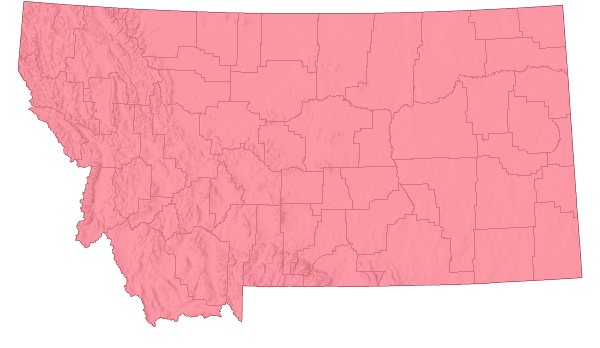
 Non-native
Non-native
Range Comments
Shattercane originated in northeastern Africa where archeological evidence suggests it has been cultivated as a cereal crop for at least 3,000 years (Barkworth in FNA 2003). It was introduced to the western hemisphere in the sixteenth century (Barkworth in FNA 2003). It currently extends from southeastern Canada through the continental United States and into Mexico.
In Montana the first documented specimen was found in 1980 in Missoula County where ballast got deposited within the railroad right-of-way (posted by April 11, 2019 at https://www.pnwherbaria.org).
Observations in Montana Natural Heritage Program Database
Number of Observations: 1
(Click on the following maps and charts to see full sized version)
Map Help and Descriptions
Relative Density
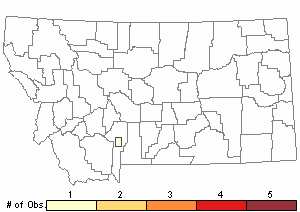
Recency
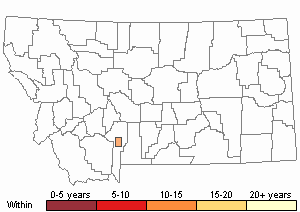

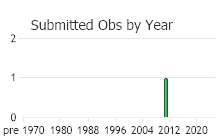
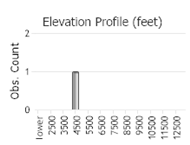 (Observations spanning multiple months or years are excluded from time charts)
(Observations spanning multiple months or years are excluded from time charts)
Habitat
Shattercane can be found along field margins and in cultivated and abandoned fields (Canadian Food Inspection Agency (CFIA) 2017). It tolerates a range of soil conditions (CFIA 2017). In Montana it is found in cultivated fields, where it rarely escapes (Lesica et al. 2017).
Ecology
CULTIVATION [Adapted from CFIA 2017]
Shattercane is typically grown as a cereal crop in hot, semi-arid tropical environments but is also found in temperate regions. It is the fifth most important cereal crop in the world. it is cultivated mostly for forage, such as milo and sorgo (Lesica et al. 2012). It grows in a range of soil conditions. It is extremely drought tolerant because of its extensive root system, waxy glaucous leaf coating, and ability to stop growing under environmental stress. It produces chemical compounds that inhibit the growth of other plants (allelopathy).
In Montana seeds have a poor ability to overwinter and seedlings do not compete well with other weeds or crops (CFIA 2017).
Reproductive Characteristics
Plants reproduce by seeds.
DISPERSAL [Adapted from CFIA 2017]
Seeds are dispersed by animals, especially birds and white tailed deer, who consume them (CFIA 2017). Humans, through their cultivation of Shattercane, have dispersed it across the globe.
HYBRIDIZATION
Shattercane hybridizes readily with Johnson Grass (Sorghum halepense) and their progeny are wide-spread in the United States (Barkworth in FNA 2003).
LIFE CYCLE [Adapted from CFIA 2017]
Flowers develop 55 to 70 days after seed germination. The flowers are usually self-fertilized but will occasionally cross-pollinate when pollen is borne in the air. After pollination, seeds mature in about 30 days.
Management
In portions of the U.S. Shattercane has been controlled using tilling and chemicals (CFIA 2017). Chemicals used elsewhere include the herbicides clethodim, fluazifop, imazethapyr, primisulfuron, dicamba, atrazine, glyphosate, and S-metolachlor.
Consult your County Extension Agent and/or Weed District for information on herbicidal control and chemicals lawful to use in Montana. The herbicide type and concentration, application time and method, environmental constraints, land use practices, local regulations, and other factors will determine its effectiveness and impact to non-target species. Strict adherence to application requirements defined on the herbicide label will reduce risks to human and environmental health. Chemical information is also available at
Greenbook.
Stewardship Responsibility
Threats or Limiting Factors
In warmer climates than found in Montana, Shattercane can escape cultivation becoming invasive.
References
- Literature Cited AboveLegend:
 View Online Publication
View Online Publication Canadian Food Inspection Agency (CFIA). 2017. The Biology Sorghum bicolor (L.) Moench (Sorghum). Canadian Food Inspection Agency, Plant Health Science Division, Plant and Biotechnology Risk Assessment Unit.
Canadian Food Inspection Agency (CFIA). 2017. The Biology Sorghum bicolor (L.) Moench (Sorghum). Canadian Food Inspection Agency, Plant Health Science Division, Plant and Biotechnology Risk Assessment Unit. Flora of North America Editorial Committee. 2003. Flora of North America North of Mexico. Vol. 25. Magnoliophyta: Commelinidae (in part): Poaceae, part 2. Oxford Univ. Press, New York. xxv + 781 pp.
Flora of North America Editorial Committee. 2003. Flora of North America North of Mexico. Vol. 25. Magnoliophyta: Commelinidae (in part): Poaceae, part 2. Oxford Univ. Press, New York. xxv + 781 pp. Lesica, P., M.T. Lavin, and P.F. Stickney. 2012. Manual of Montana Vascular Plants. Fort Worth, TX: BRIT Press. viii + 771 p.
Lesica, P., M.T. Lavin, and P.F. Stickney. 2012. Manual of Montana Vascular Plants. Fort Worth, TX: BRIT Press. viii + 771 p.
- Additional ReferencesLegend:
 View Online Publication
View Online Publication
Do you know of a citation we're missing? Hemming, B.C. 1982. Plant-associated fluorescent pseudomonads: their systematic analysis, microbial antagonism and iron interaction. Ph.D. Dissertation. Bozeman, MT: Montana State University. 154 p.
Hemming, B.C. 1982. Plant-associated fluorescent pseudomonads: their systematic analysis, microbial antagonism and iron interaction. Ph.D. Dissertation. Bozeman, MT: Montana State University. 154 p. Lesica, P., M.T. Lavin, and P.F. Stickney. 2022. Manual of Montana Vascular Plants, Second Edition. Fort Worth, TX: BRIT Press. viii + 779 p.
Lesica, P., M.T. Lavin, and P.F. Stickney. 2022. Manual of Montana Vascular Plants, Second Edition. Fort Worth, TX: BRIT Press. viii + 779 p. Maxwell, B.D. 1984. Changes in an infested plant community after an application of picloram, the effect of glyphosate on bud dormancy, the effect of pulling and the fuel potential of leafy spurge (Euphorbia esula L.). M.Sc. Thesis. Bozeman, MT: Montana State University. 73 p.
Maxwell, B.D. 1984. Changes in an infested plant community after an application of picloram, the effect of glyphosate on bud dormancy, the effect of pulling and the fuel potential of leafy spurge (Euphorbia esula L.). M.Sc. Thesis. Bozeman, MT: Montana State University. 73 p.
- Web Search Engines for Articles on "Shattercane"





